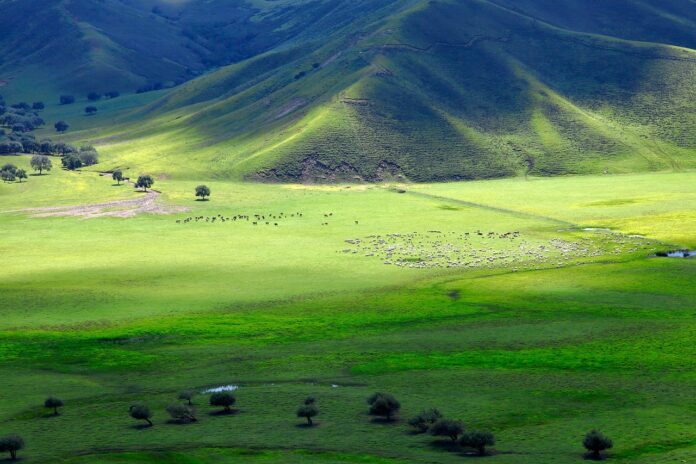26 Interesting Facts About Mongolia
- Location and Borders: Mongolia is located in East and Central Asia. It is a landlocked country bordered by Russia to the north and China to the south, east, and west.
- Square: The country covers an area of approximately 1.56 million square kilometers.
- National Currency: The currency of Mongolia is the Mongolian Tugrik (MNT).
Interesting Facts About Mongolia:
- Gobi Desert: Mongolia is home to the Gobi Desert, the third largest desert in the world. It is divided into black, red, and yellow regions based on the varying colors of its terrain.
- Fish Consumption: Historically, Mongolians did not eat fish because aquatic creatures were considered sacred. Even today, fish consumption remains rare despite the availability of fish in the country’s lakes.
- Smallest Stock Exchange: The Mongolian Stock Exchange is the smallest in the capitalist world and is housed in a renovated children’s cinema.
- Religious Diversity: Mongolia is one of the least religious countries globally. According to the latest census, around 40% of the population does not practice any religion.
- High Plateau: The country is characterized by a vast plateau, with elevations ranging from 900 to 1500 meters above sea level.
- Mongol Empire: The Mongol Empire was the largest empire in history, covering 22% of Mongolia’s territory at its peak and was one of the most powerful empires of its time.
- Internet Usage: Despite its ancient history, Mongolia is keeping pace with technological progress, with about a quarter of its population using the internet.
- Livestock Losses: Between 2009 and 2010, Mongolia experienced severe weather conditions, resulting in the loss of approximately 9.7 million animals, which significantly impacted many families.
- Yurt Measurement: The size of a traditional Mongolian yurt (ger) is measured by the number of walls rather than square meters. The smallest yurts have four walls, while the most elaborate ones have up to seven.
- Cashmere Production: Mongolia is the second-largest producer of cashmere goat wool in the world, after China, accounting for 20% of the global market.
- Ancient State: The first state in the territory of modern Mongolia, ruled by the Xiongnu emperor, emerged in the late 3rd century BC.
- Size Comparison: Mongolia is 37 times larger than the Netherlands, yet the total length of roads in the Netherlands is 67 times greater than in Mongolia.
- Oldest Rabbit Fossil: The oldest known rabbit fossil, dating back 55 million years, was discovered in Mongolia.
- Hospitality and Dining: Mongolians are known for their hospitality. Questions about food are considered impolite, so the host will typically serve a meal until the guest says “enough.”
- Yak Population: Mongolia is the second-largest country in terms of yak population, after China.
- Traditional Cheese: The traditional cheese called “baislag” is made from yak milk and is a staple in Mongolian cuisine.
- Urbanization: Mongolia has only three major cities, with nearly 45% of the population residing in the capital, Ulaanbaatar. About 30% of the population considers themselves nomadic, while the rest live in smaller towns and villages.
- Tallest Trees: Larch trees are the tallest trees in Mongolia, reaching up to 45 meters in height.
- Mongolian Script: Mongolia uses the traditional vertical script derived from the Old Uyghur script. It was the standard script for centuries until Cyrillic was adopted in the 20th century, but the vertical script is still taught and used in some contexts.
- Naadam Festival: The Naadam Festival, celebrated every July, is a traditional festival featuring the “Three Manly Sports”: wrestling, horse racing, and archery. It’s one of the most significant cultural events in Mongolia.
- Mountains and Peaks: Mongolia’s highest peak is Khuiten Peak in the Tavan Bogd mountain range, reaching 4,374 meters (14,350 feet) above sea level.
- Largest Lake: Lake Khövsgöl, often referred to as the “Blue Pearl of Mongolia,” is the largest freshwater lake in the country and one of the most pristine in Asia.
- National Symbols: The national symbol of Mongolia is the Soyombo, a traditional symbol that represents freedom and independence, and is featured on the national flag.
- Rare Earth Elements: Mongolia is rich in natural resources, including rare earth elements. The Oyu Tolgoi mine is one of the largest known reserves of copper and gold in the world.
- Population Density: Mongolia is one of the least densely populated countries in the world, with an average of about 2 people per square kilometer.
- Genghis Khan’s Legacy: The legacy of Genghis Khan is celebrated in Mongolia, where his birthday is a national holiday, and many places, including the capital city, Ulaanbaatar, are named in his honor.
